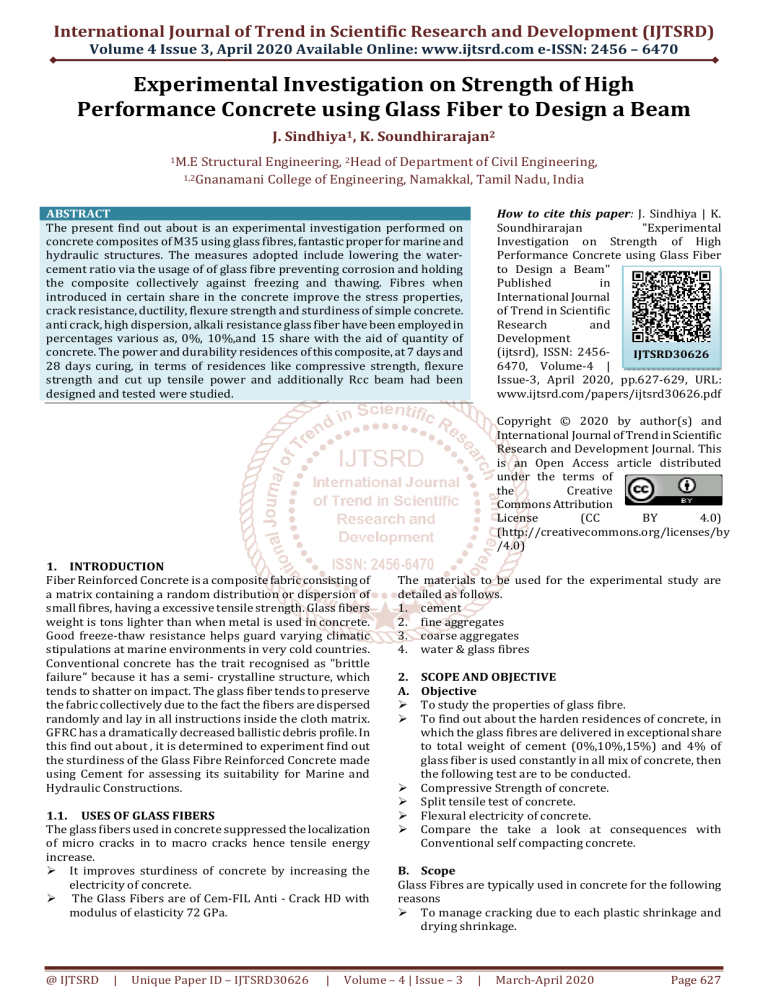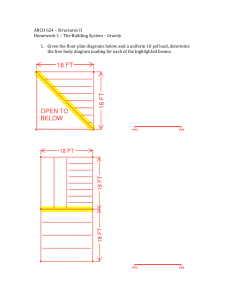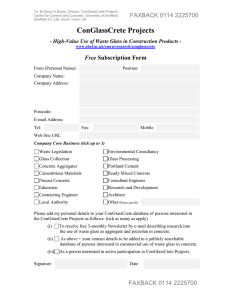
International Journal of Trend in Scientific Research and Development (IJTSRD)
Volume 4 Issue 3, April 2020 Available Online: www.ijtsrd.com e-ISSN: 2456 – 6470
Experimental Investigation on Strength of High
Performance Concrete using Glass Fiber to Design a Beam
J. Sindhiya1, K. Soundhirarajan2
1M.E
Structural Engineering, 2Head of Department of Civil Engineering,
1,2Gnanamani College of Engineering, Namakkal, Tamil Nadu, India
How to cite this paper: J. Sindhiya | K.
Soundhirarajan
"Experimental
Investigation on Strength of High
Performance Concrete using Glass Fiber
to Design a Beam"
Published
in
International Journal
of Trend in Scientific
Research
and
Development
(ijtsrd), ISSN: 2456IJTSRD30626
6470, Volume-4 |
Issue-3, April 2020, pp.627-629, URL:
www.ijtsrd.com/papers/ijtsrd30626.pdf
ABSTRACT
The present find out about is an experimental investigation performed on
concrete composites of M35 using glass fibres, fantastic proper for marine and
hydraulic structures. The measures adopted include lowering the watercement ratio via the usage of of glass fibre preventing corrosion and holding
the composite collectively against freezing and thawing. Fibres when
introduced in certain share in the concrete improve the stress properties,
crack resistance, ductility, flexure strength and sturdiness of simple concrete.
anti crack, high dispersion, alkali resistance glass fiber have been employed in
percentages various as, 0%, 10%,and 15 share with the aid of quantity of
concrete. The power and durability residences of this composite, at 7 days and
28 days curing, in terms of residences like compressive strength, flexure
strength and cut up tensile power and additionally Rcc beam had been
designed and tested were studied.
Copyright © 2020 by author(s) and
International Journal of Trend in Scientific
Research and Development Journal. This
is an Open Access article distributed
under the terms of
the
Creative
Commons Attribution
License
(CC
BY
4.0)
(http://creativecommons.org/licenses/by
/4.0)
1. INTRODUCTION
Fiber Reinforced Concrete is a composite fabric consisting of
a matrix containing a random distribution or dispersion of
small fibres, having a excessive tensile strength. Glass fibers
weight is tons lighter than when metal is used in concrete.
Good freeze-thaw resistance helps guard varying climatic
stipulations at marine environments in very cold countries.
Conventional concrete has the trait recognised as "brittle
failure" because it has a semi- crystalline structure, which
tends to shatter on impact. The glass fiber tends to preserve
the fabric collectively due to the fact the fibers are dispersed
randomly and lay in all instructions inside the cloth matrix.
GFRC has a dramatically decreased ballistic debris profile. In
this find out about , it is determined to experiment find out
the sturdiness of the Glass Fibre Reinforced Concrete made
using Cement for assessing its suitability for Marine and
Hydraulic Constructions.
1.1. USES OF GLASS FIBERS
The glass fibers used in concrete suppressed the localization
of micro cracks in to macro cracks hence tensile energy
increase.
It improves sturdiness of concrete by increasing the
electricity of concrete.
The Glass Fibers are of Cem-FIL Anti - Crack HD with
modulus of elasticity 72 GPa.
@ IJTSRD
|
Unique Paper ID – IJTSRD30626
|
The materials to be used for the experimental study are
detailed as follows.
1. cement
2. fine aggregates
3. coarse aggregates
4. water & glass fibres
2.
A.
SCOPE AND OBJECTIVE
Objective
To study the properties of glass fibre.
To find out about the harden residences of concrete, in
which the glass fibres are delivered in exceptional share
to total weight of cement (0%,10%,15%) and 4% of
glass fiber is used constantly in all mix of concrete, then
the following test are to be conducted.
Compressive Strength of concrete.
Split tensile test of concrete.
Flexural electricity of concrete.
Compare the take a look at consequences with
Conventional self compacting concrete.
B. Scope
Glass Fibres are typically used in concrete for the following
reasons
To manage cracking due to each plastic shrinkage and
drying shrinkage.
Volume – 4 | Issue – 3
|
March-April 2020
Page 627
International Journal of Trend in Scientific Research and Development (IJTSRD) @ www.ijtsrd.com eISSN: 2456-6470
They additionally minimize the permeability of concrete
and thus minimize bleeding of water.
Some types of fibres also produce higher impact,
abrasion and shatter resistance in concrete.
The fineness of the fibres approves them to improve the
mortar fraction of the concrete, delaying crack
formation and propagation.
This fineness also inhibits bleeding in the concrete,
there by using reducing permeability and improving the
floor traits of the hardened surface.
10, 15 were adopted in the experimental programmed. Glass
fibres had been introduced in the mix by volume of concrete.
The entire mix was homogeneously mixed with calculated
amount of water and plasticizer. The compressive energy
take a look at specimens had been of dimensions one
hundred × 100 × 100mm.The split tensile electricity check
specimens have been of dimensions 150mm diameter ×
300mm length. These specimens were forged and tested
after 7 days and 28 days of curing as per IS specification.
3. MATERIAL PROPERTIES
3.1. PROPERTIES OF CEMENT
It is one of the best binding materials used in civil
engineering construction. It has high plastic properties. It
offers high strength to masnory. It hardens is short time. It
attains early setting. It is easily workable.
Figure.3.3 Casting and Curing of Specimens
Table 3.1 Physical Properties of Cement
3.2. GLASS FIBRE
The glass fiber used is alkali-resistance glass fiber which has
a cut size of 12mm and a diameter of 14 microns.
Table 3.3 Details Of Test Specimens
4.1. DESIGN A BEAM
The layout of beam is got from concrete RCC beam of
diameter 700x100x100mm. The trying out is finished after
curing for 28 days.
Figure.3.2 Glass fibre
Figure 3.4 Testing Setup For Beam
Table 3.2 properties of glass fibre
4. EXPERIMENTAL WORKS
Concrete used to be organized by a combine proportions of
M35 grade concrete. The different percentage of fibres like 0,
@ IJTSRD
|
Unique Paper ID – IJTSRD30626
|
The concrete mixes have been crammed in the beam moulds
after laying the reinforcements with the required cover and
compacted effectively by way of the use of damping rod. The
beams dimensions 700mm x 100mm x 100mm have been
casted for each layout mixes. The beam is equipped with
extensometer having gauge size now not much less than 10.2
cm and not more than 1/2 the size of the specimen. On
getting rid of the beam from the water and while it is
nevertheless in the wet condition, the extensometers are
connected at the ends, in such a way that the gauge factors
are symmetrical about the centre of the specimen and in
nose are nearer to either end of the specimen. The specimen
Volume – 4 | Issue – 3
|
March-April 2020
Page 628
International Journal of Trend in Scientific Research and Development (IJTSRD) @ www.ijtsrd.com eISSN: 2456-6470
is immediately positioned in the Compression Testing
Machine and precisely centered. The load is applied
continually and without shock at a rate of one hundred
seventy kg / sq cm / min. The extensometer readings
corresponding to the load increments were noted.
5. RESULTS AND DISCUSION
5.1. COMPRESSIVE STRENGTH TEST RESULT
Figure5.3 FLEXURAL STRENGTH TEST GRAPH
6. CONCLUSION
In this study, it is concluded that the range of Glass Fibre
Concrete made an first-rate preference for marine and
hydraulic shape constructions, as compressive energy and
tensile power will increase with extend in share of glass fibre
with appreciate to quantity of concrete. Also since, the
deterioration determined for chloride resistance is
determined to be very less.
Table.5.1 COMPRESSIVE STRENGTH OF M35
Figure 5.1 COMPRESSIVE STRENGTH TEST GRAPH
5.2.
SPLIT-TENSILE STRENGTH TEST RESULTS
As this composite will increase tensile energy it may also
limit the place of metal reinforcement required, minimizing
the deterioration in marine environments and hydraulic
structures. If any due to corrosion of metal reinforcements.
As tensile, flexural and compressive energy will increase
with extend in share of glass fibre with appreciate to
quantity of concrete, marine and hydraulic structural factors
can be supplied with greater concrete cowl supported
through glass fiber, which makes it tough for factors that
purpose deterioration to attain the floor of metal
reinforcements, stopping corrosion and growing the
existence of concrete in these environments.
REFERENCE
[1] Deshmukh S. H. , Bursary J. P , Zende A. M. (2012),
“Effect of Glass Fibres on Ordinary Portland cement
Concrete” IOSR, Journal Of Engineering, June 2012,
Vol.2(6) pp: 1308-1312.
[2] Neel Shah, Dr. Indrajit, N. Patel (2013) “Tensile
Strength of High Performance Concrete Using
Supplementary Cementing Material and Glass Fiber”,
Indian Journal of Applied Research, July 2013 ,Volume
3, Issue 7, pp 257-259.
Table.5.2 SPLIT TENSILE STRENGTH OF M35
[3] Philipp Lober, Klaus Holschemacher, “Structural Glass
Fiber Reinforced Concrete for Slabs on Ground”, World
Journal of Engineering and Technology, 2014, 2, 48- 54.
[4] Rama Mohan Rao. P, Sudarsana Rao. H, Sekar. S, “Effect
of Glass Fibres fly ash based Concrete”, International
Journal of Civil and Structural Engineering, Volume 1,
No 3, 2010, pp 606-612.
Figure.5.2 SPLIT TENSILE STRENGTH TEST GRAPH
5.3.
FLEXURAL STRENGTH TEST RESULTS
[5] “Strength and Workability Characteristics of Fly Ash
Based Glass Reinforced High PerformanceConcrete”(2008) by Dr. H. SudarsanaRao, International
Journal of Engineering Science and Technology (IJEST),
Vol.3 No. 8 August 2011, pp 6266- 6277.
[6] P. Bhuvaneshwari, (2013) “Strength characteristics of
glass fiber on bottom ash based concrete”,
International Journal of Science, Environment and
Technology, Vol.2, No 1, 2013, 90 – 102.
Table.5.3 FLEXURAL STRENGTH OF M35
@ IJTSRD
|
Unique Paper ID – IJTSRD30626
|
Volume – 4 | Issue – 3
|
March-April 2020
Page 629




